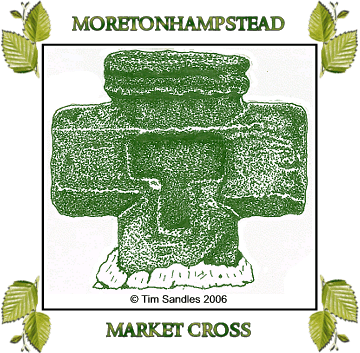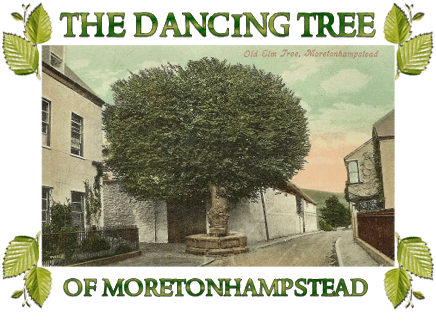
Although long gone there once stood a mighty and venerable elm tree in Moretonhampstead, it was known by various names; The Cross Tree, The Dancing Tree and The Punchbowl Tree. The history of the tree is an ironic reversal of the normal situation whereby pagan symbols were replaced by Christian ones. It is known that a market cross stood on what was at one time church lands prior to 1636. The granite cross had a rectangular recess between the arms on one side and another ‘T’ shaped one on the other face, the top of the cross consisted of an oval depression surrounded by a raised rim. These possibly contained icons and holy water. After the reformation the cross fell into disuse and somehow an elm tree seed managed to germinate in the pedestal which held the cross. Either through lack of concern for the cross or simple neglect the tree established itself and eventually its spreading roots managed to topple the cross. This resulted in the shaft breaking and the head separating, the broken shaft was taken away and probably used in some other capacity such as a gatepost. The head remained and to this day can be seen at the base of a modern tree, therefore the original tree, seen by some as a pagan symbol managed to oust the Christian symbol, ie the granite cross. This association with the old market cross is why the tree became known as ‘The Cross Tree’.

As time passed the elm tree flourished and in 1799 a local man, John Hancock decided to open an inn near the tree. After two applications, a licence was finally granted giving him permission to open his hostelry which he called ‘The London Inn & Tavern’. Hancock then undertook to pollard the elm tree which resulted in the tree taking on the appearance of a punchbowl, which is how it also became known as, ‘The Punchbowl Tree’. So it was that on special occasions such as Mayday and the like, many of the celebrations were held around the tree. In 1801, a witness to such an event wrote the following;
“The Cross Tree floored and seated around, with a platform, railed on each side, from the top of an adjoining wall to the tree, and a flight of steps in the garden for the company to ascend. After passing the platform they enter under a grand arch made of boughs. There is sufficient room for thirty persons to sit around, and six couples to dance, besides the orchestra”.
It was because of this custom that the tree acquired its third alternative name – The Dancing Tree.

During the Napoleonic wars the paroled French Officers who in effect were prisoners of war would congregate around the tree. Their band would then entertain both locals and officers with their music. The tree was still in good order by 1862 when it became something of a tourist attraction. But the disaster literally struck when on the 13th of October 1891 a violent storm blew down much of the tree including a large part of the hollow trunk and much of the upper canopy. Following this a man named Harvey managed, with the aid of bands and iron nails, to restore the mighty elm. Bravely the tree struggled for its life but once again, 12 years later another storm completely destroyed it. Following this tragedy, Mr A. C. Loveys planted a new tree but this too was doomed and never managed to establish itself. Another attempt at replacing the old tree was undertaken in 1912, this time a copper beech was planted and its is this tree that stands on the site today. When the new tree was planted it was decided that the original head of the old market cross should be re-sited and iron railings erected to protect both tree and cross head.

Today the tree still stands and the head of the market cross still sits under its leafy canopy, the iron railings have disappeared presumably as a contribution to the war effort. There is still a tradition that lingers from the days of the French prisoners of war and that is the sad story of a man who played the fiddle in the military band. During the war there were times when French prisoners would be repatriated in exchange for a British prisoner and the fiddler was lucky enough to be one such exchange. But sadly the day before he was to be returned home he died, his remains were buried in the church. It is said that on some nights you can hear the sad melodic sounds of his fiddling emanating from ‘The Cross Tree’.
The tree had another claim to fame and that was its inclusion in R. D. Blackmore’s book – ‘Christowell’. In the novel, Blackmore gives the following description:
“Instead of putting up a May-pole then, and frolicking around it, in a Pixy ring, the young folk of Moreton have their frisks among the verdure, without dread of dewy feet or toes stuck in a mole hill. High up in the tree, which stand in an elbow of Scraggy Street, they hoist and fix a timber platform, strong enough to bear the vehemence of dancing feet not too aerial. The boughs of the patulous tree, above the hole, afford a noble amplitude; and a double ring of hay rope, woven fast around the branches, provides the most headlong couple with a chance of preserving their necks, when valuable.”
Sadly this dancing tree has now been removed.
 Legendary Dartmoor The many aspects past and present of Dartmoor
Legendary Dartmoor The many aspects past and present of Dartmoor

Your comment is awaiting moderation.
Hello Tim
We have an account of the Moretonhampstead Dancing Tree in ‘Short Devonshire Stories’ by Rev W.H. Thornton, Rector of North Bovey, dated1915. You may have this too, but if not, he has two pages on it, including how Widgery painted it in a rather unusual fashion, and contemporary references from June 4 1800, August 26 1801 and August 19 1807. He also reports how the garden wall supporting the dancing platform was Dr Coleridge’s wall, and sometimes had a gallery from one of the upper windows of his house. He says that there were other dancing trees at Great Fulford, where they Fulfords dined once a year while the tenantry danced around the tree. It was an oak, near Cheriton Cross on the Okehampton Road; and there was also one at Trebursaye, near Launceston, where one dancing girl fell off and broke her neck. She then inconsiderately haunted the tree and had to be exorcised by Mr Penale the vicar.
If any of this is interesting and or new for you, do tell us. We have quite a lot of books about Devon.
Bye now
Greg and Viv Martin